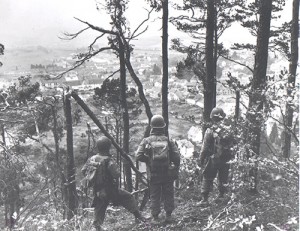Japanese-American Unit Compiled Heroic Record in Battle

Nov. 14, 2013 – The old man wearing a bright white shirt and veterans’ cap stood stiffly at attention, saluting as four soldiers in dress uniforms briskly hoisted colors into the blue sky above Miramar National Cemetery.
Sixty-nine years earlier – October 1944 – he had been in the Vosges Mountains of northeastern France, a young Japanese American wearing a helmet, dirty fatigues and muddy combat boots, and carrying a rifle. His unit, the famous 442nd/100th Regimental Combat Team was engaged in a battle to liberate the French villages of Bruyères, Belmont and Biffontaine.
But on this day, Nov. 14, 2013, former Staff Sgt. Frank M. Wada’s only duty was to salute the flag he had proudly served as it snapped in the warm wind. Gathered around the 92-year-old Spring Valley resident during the private flag-raising ceremony were a dozen or so family members and friends.
The Miramar National Cemetery Support Foundation sponsored the event both to honor Staff Sgt. Wada, and to express appreciation to the Wada family for their contribution of funds to purchase several new flags for the cemetery’s Avenue of Flags. The impressive 50-flag display lining the cemetery’s main thoroughfare can be seen around-the-clock, 365 days a year.
During a brief ceremony following the flag-raising, Foundation President and CEO Dr. Gary Parks presented an engraved medallion to Staff Sgt. Wada commemorating the event. In 2011, he and other veterans of the 442nd/100th were awarded Congressional Gold Medals in recognition of their service in World War II. The medal is embossed on one side with images of unit members at war and on the other with illustrations of the unit’s shoulder patches.
The Wada family is pleased to make the donation on behalf of her father, and in remembrance of his wife, Jean, who is buried at Miramar, said daughter Janet Kobayashi. “It’s a really good thing that the public can make donations to purchase flags for the Avenue of Flags. Younger people need to be able to grasp this, to feel it in their hearts. That’s why my Dad said, ‘OK’, to participating in the ceremony.”
Her father doesn’t like to talk about his time at war, Kobayashi said, or the months he spent in a Poston, Ariz., camp where he and his family, and hundreds of other Japanese Americans were interned following the attack on Pearl Harbor. The only positive thing that happened in the camp was his marriage to fellow internee Jean Ito. Two weeks after the wedding, he left the camp for Army training. He was 21 years old.
At the training camp, Wada joined other Japanese Americans – Nisei or second-generation – from the mainland internment camps, and a large contingent of Hawaii-born men of Japanese descent. The earliest enlistees joined the 100th Battalion, while the newer men formed the 442nd. Eventually, the two battalions were joined into one and, over time, they were welded into an effective fighting force. Sent to Europe, where they fought in Italy and France, their cohesion and valor in battle often found them in the thick of the most brutal combat.

Wada first experienced combat north of Rome in June 1944 as a member of the combined 442nd/100th Regimental Combat Team. Under the command of General Mark Clark, the RCT – whose motto was “Go for Broke” – drove German forces north in the heavily defended mountainous terrain of northern Italy.
The next assignment for the RCT was a face-off with the enemy in the thickly forested Vosges Mountains near Germany in northern France. It was the beginning of one of the most savage campaigns of World War II, one that cost the 442nd/100th more than 900 casualties and left Staff Sgt. Wada with shrapnel wounds. He was evacuated from the battlefield and hospitalized. His war was over.
Staff Sgt. Wada has the distinction of having been a member of the most decorated unit for its size and length of service in U.S. military history. Of some 14,000 men who served, 9,486 – including Wada – were awarded Purple Hearts. Unit members also were awarded 21 Medals of Honor, 29 Distinguished Service Crosses, 588 Silver Stars and more than 4,000 Bronze Stars.
Leading the honor guard at the Miramar ceremony was Army First Sgt. Angel Martinez, an Iraq combat veteran. “I’ve been in the Army almost 16 years, and this is the first time I’ve participated in such a ceremony. Staff Sgt. Wada is an awesome human being who has a great history behind him.”
“It was an honor meeting someone of that caliber,” said Cadet John Acido, an ROTC student at SDSU who comes from a military family. “He has had the pleasure of living out his life after the war, and was able to build a great, beautiful family. It’s a big honor to be part of a ceremony like this. It creates a very strong bond.”
To contribute to the Miramar National Cemetery Support Foundation, go to www.MiramarFoundation.org for the Foundation home page. Click on the Donations link for contribution information, and to donate online or to print out a donation form.
By Bill Heard,PIO
Support Foundation
